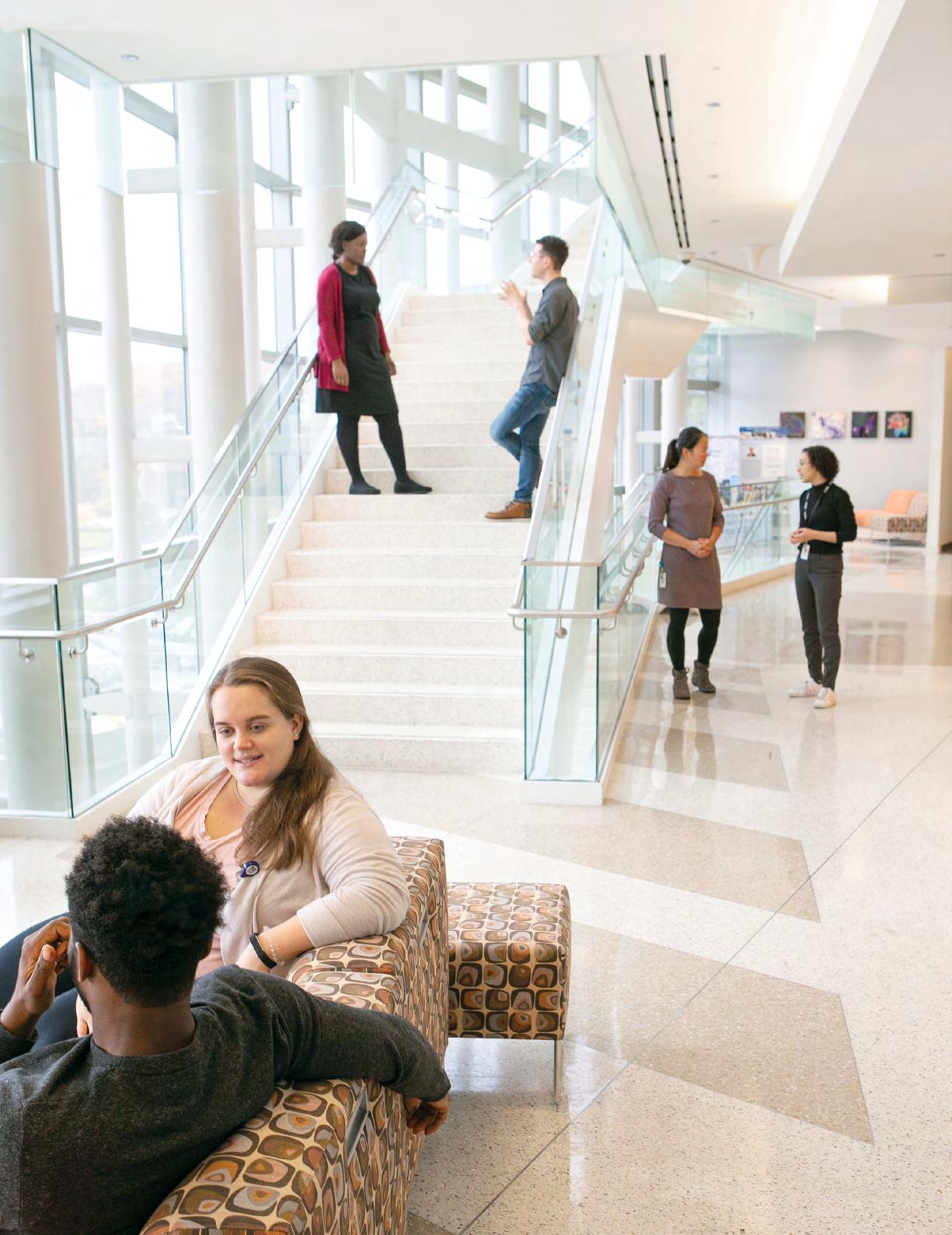
21 minute read
Executive Summary
Our 2020–2025 strategic plan, IMPACT 2025, has been created at an important point in the history of the medical school: 2020 marks the 50th anniversary of the inaugural class of 16 medical students commencing their medical education against the backdrop of a grand but uncertain experiment to launch the state’s first and only public medical school.
What began as a modest endeavor in 1970 has evolved into a substantial and enduring enterprise. The common threads that connect our past and present and that will connect the present with our future are an indefatigable spirit, a collaborative ethos, an entrepreneurial mindset and a service orientation. Our social compact compels us to engage in efforts to improve the public good. Our historic and nationally recognized excellence in educating primary care practitioners represents one noteworthy example of how our social mission manifests itself for the benefit of the communities we serve.
The sheer breadth, depth and scope of the UMass Chan enterprise of today presents our medical school with a unique opportunity to do more, for and with more people, in more places. The IMPACT 2025 planning process, which was deliberate, thoughtful and participatory, revealed a deep and abiding passion among members of the UMass Chan academic community to be more intentional about the impact we create and the social mission we propagate.
Our strategic plan presents UMass Chan with a blueprint for innovation and a roadmap for societal benefit. It presumes that foundational and core institutional values—health and wellness, collaboration and partnership, diversity and inclusion, engagement and equity, innovation and entrepreneurship, primary care and public health—will underpin our next five years of success, as well as our next 50 years of impact. It envisions aligning and leveraging the full complement of expertise, resources and people within the UMass Chan enterprise, including graduate schools of medicine, nursing, and biomedical sciences; post graduate medical education; Commonwealth Medicine; MassBiologics; and other specialized assets, as well as the broader University of Massachusetts system to expand our reach, extend our presence and deepen our influence. Most importantly, the plan calls for our emergence as a leading-edge medical school of the future—one that defines and measures success through the lens of visible and enduring contributions to human health. From individuals to communities to populations, we will make a sustained impact in furtherance of our social compact as the commonwealth’s public medical school.
Our social compact refers to our enduring institution-wide focus on service to and engagement in the Commonwealth of Massachusetts and the cities and towns in which we live and work. This compact recognizes our strong connection to the health and well-being of our state’s residents, as well as the citizens of the world. Further, it acknowledges the societal responsibility we willingly embrace to serve as an engine of discovery to generate new knowledge that can have a tangible and measurable impact on those greatest in need. Finally, our social compact compels us to be excellent stewards of precious public dollars so as to optimize and maximize institutional resources for the benefit of those we serve.
We endeavor to leverage our intellect and influence through the profound contributions made by our highly qualified, culturally competent, equity-oriented, community-engaged graduates. We intend to relentlessly pursue world-class science—from basic science discovery to trans–lational research to the science of translation, and from communityengaged and health equity research to population health and health outcomes studies. We plan to strategically invest in the best and brightest talent, including basic and applied scientists, clinicianinvestigators and computational researchers. We commit to enhancing

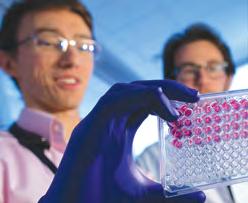
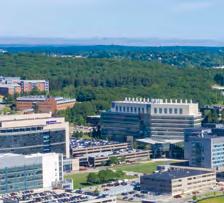
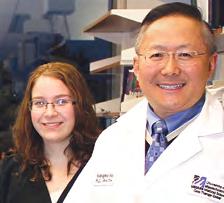
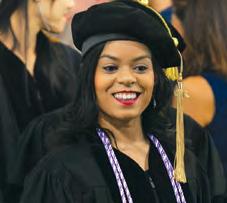
our partnership models, community engagement approaches and public health initiatives by harnessing and coordinating the collective power of the UMass Chan enterprise toward achieving health equity. Finally, we commit ourselves to elevating our social compact by sustaining excellence in stewarding the resources and assets of our valued state institution.
A summary of IMPACT 2025’s thematic goals, all of which will contribute to advancing our strategic direction and expanding our institutional impact, follow.
EDUCATION
In education, we will commit ourselves to accommodate the increasing demand for our educational offerings and to respond to the workforce needs in our state and beyond. This will necessitate pushing the boundaries of educational innovation, the focus of which will be to optimally prepare the physician, nurse and science leaders of tomorrow so that they may thrive in and adapt to complex, evolving practice environments. We will promote experiential and interprofessional learning across all three schools. In partnership with our faculty, learners and affiliates, we will refine and enhance our competency-based educational curriculum, establish new professional competencies and offer our students tailored pathways of study in leadership and entrepreneurship. So, too, our undergraduate and graduate medical education initiatives will partner to ensure that our graduates lead the revitalization and re-emergence of our affiliated residency training programs. To position our faculty educators and administrative staff to lead the development of next-generation educational pedagogy and leadership development that reflects how our future students study and learn, we will launch a learning academy. Finally, we will help our educators, staff and learners find and sustain wellness, realize personal satisfaction and achieve professional fulfillment, all of which are integral to transforming our culture and advancing our bold vision for the future.
RESEARCH
In research, to advance human health, we will integrate, synthesize and align our discovery, translation, implementation and commercialization efforts to ensure progress and to achieve impact. This will require new and enhanced engagement with our diverse portfolio of research stakeholders, including community partners and industry collaborators. Our basic science enterprise will be positioned as an engine of discovery that primes the pump of our research pipeline. Additionally, we will invest in new and complementary research programs, highlighted by the establishment of a Program in Human Genetics and Evolutionary Biology. To help drive and sustain our clinical and translational research efforts, we shall prioritize the recruitment and retention of additional exceptional and entrepreneurial clinician-scientists within the ranks of our faculty. We will explore the feasibility of earning NCI designation for our Cancer Center.
Underpinning our strategic direction in research will be an enhanced commitment to provide all who are engaged in research, discovery and innovation with bestin-class infrastructure and specialized support services. A centerpiece of this commitment will be the construction of a state-of-the-art research facility on our main campus that will house existing areas of world-class strength such as the Horae Gene Therapy Center, the Program in Molecular Medicine, neurobiology and neurotherapeutics, as well as new and emerging areas, including the Program in Human Genetics and Evolutionary Biology. Additionally, we will create an Integrative Biomarker Core that will apply powerful new technologies and integrative analytics toward the identification of new biomarkers, novel point-ofcare diagnostic devices and digital medicine capabilities.
We will augment our support for preclinical product development and early stage clinical trials to speed the translation of scientific discoveries to new treatments and approaches. An advanced therapeutics initiative will align and integrate the full complement of resources and expertise—legal, regulatory, process development, biomanufacturing, clinical trial design and management— necessary to advance and accelerate the translation of our scientific discoveries. Finally, targeted investments in data-related capabilities, including continued investment in our data lake, as well as research computing and data science technologies, will provide innovative, agile, cost-efficient and compliant technologies, tools and expertise in support of emerging scientific directions.
COMMUNITY & GLOBAL IMPACT
In the area of community and global impact, we will incorporate our social mission across all parts of the UMass Chan enterprise and emphasize the importance of the social determinants of health, health equity and community-engaged research, public service, and global health in our education and research programs. To amplify the full extent of our efforts and to more effectively tap into the collective passion and expertise of our faculty, staff and students, we will launch a Office of Health Equity that will help us to align, integrate and empower the substantial and varied scholarship, programs, projects and volunteer activities, already underway across our institution, that promote health equity and strengthen health equity research across Massachusetts and throughout the world. To further our communityengaged research and global health initiatives, we will emphasize the power of our partnerships with essential stakeholders, such as the Worcester Department of Public Health, the Commonwealth of Massachusetts Executive Office of Health and Human Services and the VA, by deploying new and enhanced partnership approaches that will help us to more effectively improve health and wellness in the communities
in which we live and work. As we begin to execute on this direction, we will recommit to measuring and enhancing our community impact through a rigorous process of assessment and continuous improvement.
OPERATIONAL EXCELLENCE & FINANCIAL STEWARDSHIP
Our institution straddles three dynamic industry sectors: higher education, health care and the life sciences. Each is marked by increasing competition and rapid transformation. To compete successfully in the broader environment in which we operate, we must be both strategic and tactical as we lead our medical school and position it for another 50 years of success and impact. Consequently, our future direction will be contingent upon exceptional stewardship of our institutional resources and assets. Essential enabling strategies, from talent management to facilities management to technology management, must be aligned with and supportive of IMPACT 2025.
In this plan, we underscore the critical need to develop a new human capital strategy that embraces diversity, inclusion and gender equity as business imperatives to position our institution as an employer of choice for the global talent pool from which we draw our workforce. We will augment our educational, research and service missions by creating innovative and cuttingedge technology solutions that transform the ways in which we plan, manage and utilize our physical assets and infrastructure. Further, we will more fully leverage the wholly unique platforms that exist within Commonwealth Medicine and MassBiologics, as well as the specialized expertise embedded in BRIDGE, our business development arm, and our Office of Advancement. These distinguishing assets of our medical school will serve as impact multipliers, intensifying the effects of the work we undertake as the commonwealth’s first and only public medical school. As our medical school charts an ambitious and dynamic future direction, we remain cognizant of and committed to the broader university system that we are privileged to be a part of and proud to help shape. As the Nobel Prize-winning health sciences campus of the university, our medical school is an integral and impactful component of the UMass system. Our specialized mission, world-class faculty, cuttingedge programs, state-of-the-art infrastructure and collaborative ethos position us as a partner of first choice for the other UMass campuses. We welcome such collaborative efforts and engage actively and enthusiastically. Partnership examples include: the UMass system-wide Center for Clinical and Translational Science; driving the five-campus life sciences strategic plan; coordinating the establishment of the UMass baccalaureate-MD pathway program; and developing mutually beneficial partnerships with specific campuses. Our UMass Lowell partnership around the Massachusetts Medical Device Development Center, as well as our MPH and MBA dual degree programs with UMass Amherst and UMass Lowell, respectively, serve as tangible and successful examples of our campus-specific collaborations. Consistent with IMPACT 2025’s strategic direction, we will continue to contribute to the growth, success and achievement of the UMass system by engaging our fellow UMass campuses and making available to them our unique and complementary expertise, resources and assets.
DIVERSITY, EQUITY & INCLUSION
Our goals related to education, research, community and global impact or operational excellence and financial stewardship will not be fully and truly realized unless and until we commit to creating a diverse, equitable, anti-racist, and inclusive community for our learners, faculty and staff. In partnership with the Diversity and Inclusion Office, colleagues across our enterprise will have access to trainings and educational opportunities, speakers’ series, service on interprofessional committees and affinity groups as a source of support as well as personal and professional development. A cornerstone of our DEI strategic goal will be the adoption of departmentspecific Diversity and Equity Action Plans, known as DEAPs, to fully engage colleagues across all of our mission areas in helping UMass Chan advance the health and wellness of our diverse communities throughout Massachusetts and across the world by leading and innovating in education, research, health care delivery and public service.
IN CONCLUSION
As we look to the next 50 years of achievement at our medical school, we need only to recall the foundation of our success over our first five decades of operation: passionate people inspired by our public mission, empowered by our collaborative ethos and sustained by our optimistic outlook.
IMPACT 2025 marks the start of a new chapter in our institution’s dynamic history. By working together—across the UMass system, throughout the Commonwealth of Massachusetts and around the world—we will emerge as a leadingedge medical school of the future that makes a purposeful, persistent and profound impact on human health.
STRATEGIC GOAL EDUCATION
Advance practice, learning and leading by engaging fully with our communities to be the destination of choice for learners interested in interprofessional, team-based care and biomedical entrepreneurship
Our medical school plays a vital role in providing high-quality, affordable health sciences education to residents of and beyond the commonwealth. Over the next five years, our focus will be a continued dedicated effort to serve as a model for the future of health and life sciences education while enhancing our reputation for leadership in teaching and learning innovation.
While the challenges ahead for our educational mission are significant, we embrace them as meaningful opportunities for continued leadership and innovation. In the years ahead, we intend to lead from the front by pushing the boundaries of educational innovation, the focus of which will be to optimally prepare the physician, nurse and science leaders of tomorrow so that they may thrive in and adapt to complex, evolving practice environments.
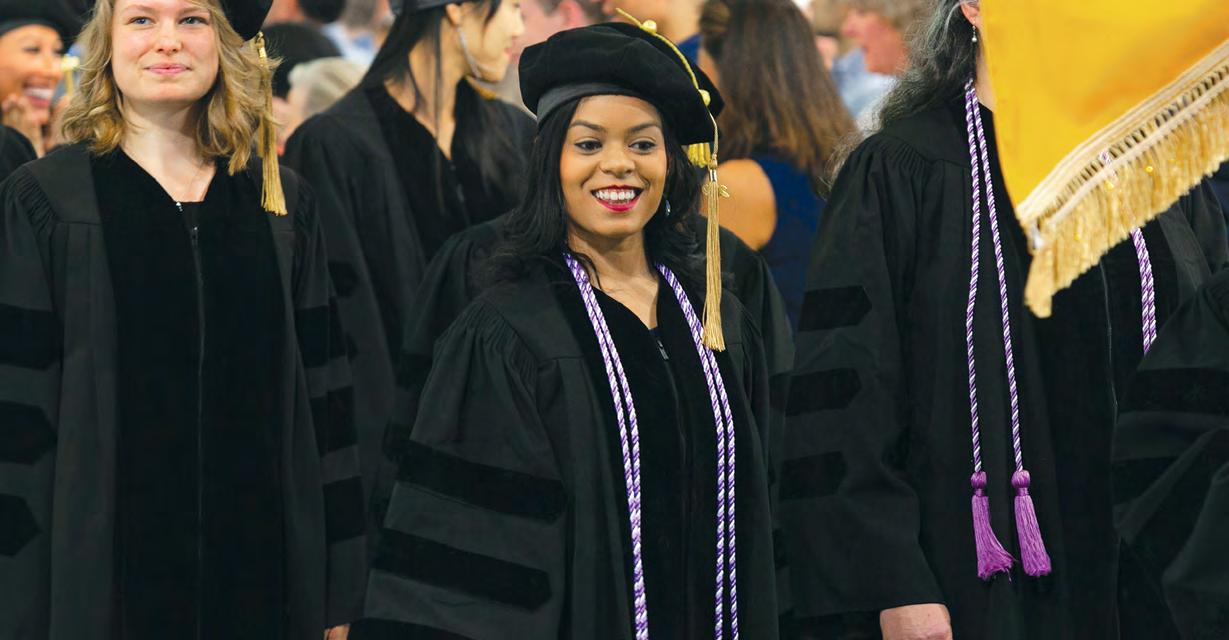
The following educational priorities will help drive our strategic direction:
DESIGNING INNOVATIVE EDUCATIONAL PROGRAMMING
Establish new tailored pathways of study in advanced practice, entrepreneurship and leadership as we engage with our communities as partners in the educational experience and develop an expanded set of professional competencies to respond to the unique needs of our learners and evolving practice environments
Recruit, support and celebrate a diverse and inclusive educational community, providing curricula and learning environments that effectively address bias
Embrace and enable interprofessional collaboration and learning among our undergraduate, graduate medical education and nursing learners, through new opportunities to engage in interprofessional project work and interdisciplinary communitybased learning
Lead the development of next generation educational pedagogy by providing targeted support to faculty and staff focused on core competencies, teaching methods innovation, engagement skills and leadership development
RESPONDING TO WORKFORCE NEEDS, DEMANDS AND TRENDS
Continue to expand the range, diversity and quality of preclinical resources and clinical placements to keep pace with expanding enrollment, workforce demands, curricular innovation and the needs of those we serve
PRIORITIZING EDUCATOR AND LEARNER WELLNESS
Prioritize wellness integration to encourage and support the wellbeing of all stakeholders in our educational community
OUR EDUCATIONAL COMMUNITY
comprises the T.H. Chan School of Medicine and a regional campus, UMass Chan-Baystate, located in Springfield, MA; the Morningside Graduate School of Biomedical Sciences; the Tan Chingfen Graduate School of Nursing; and Graduate Medical Education. Taken collectively, our learning environment has been recognized consistently for academic excellence, high student satisfaction and outstanding educational outcomes. While we are proud to offer our graduate students, residents and fellows an exceptional education, we cannot rest on past accomplishments or present achievements. The professions and practice environments that our graduates will enter are characterized by a perpetual state of assessment and change. Therefore, we are compelled to ensure that our academic programs keep pace and continually adapt to external changes and trends.
DESIGNING INNOVATIVE EDUCATIONAL PROGRAMMING
In the coming years, as the health care and biomedical research landscapes evolve, we will ensure that we are responding to the educational needs of our students and the workforce demands of our state and of the health care and life sciences professions. We will renew our commitment to optimally prepare our diverse learners to adapt and thrive during their career journeys. We will be at the forefront of developing new curricula and teaching methodologies that incorporate and support an enhanced and expanded set of professional competencies from which our graduates will draw in order to excel in their professions.
Tailored pathways of study that engage our communities as partners in the educational experience will characterize our modernized curriculum. Entrepreneurship and leadership skills will be prioritized in our new programs of selfdirected learning. Additionally, as our plan progresses, we will engage MassBiologics, Commonwealth Medicine and the UMass Center for Clinical and Translational Science to explore opportunities to leverage their unique expertise to provide our learners with additional educational pathways focused on areas such as regulatory science and health policy.
An expanded menu of learning experiences will support students in the acquisition of new competencies within health systems science including, but not limited to, valuebased care, population health, behavioral health and social determinants of health. Technology advances will be leveraged to enhance teaching and learning while enabling students, residents and fellows to pursue experiential learning and reallife problem solving in both clinical and community settings.
We will be intentional and strategic about weaving our social compact as
a public medical school into the priorities and programming of our schools with a goal of educating outstanding, altruistic leaders and lifelong learners in medicine, science and nursing. We will emphasize service learning and community engagement as central tenets of our educational programs and promote existing initiatives, such as the Worcester Free Medical Program, that align with and reinforce our core values. We also will ensure that our curriculum offerings support an enhanced learning environment that fosters intellectual curiosity, emotional intelligence, interprofessional and team-based collaboration, student engagement, and improved learning outcomes.
Health care in the 21st century is built upon patient- and familycentered interprofessional collaborative practice. Our learning environments and the educational experience we offer to our students and trainees will be distinguished by a fully integrated interprofessional framework across our three schools and graduate medical education programs. As a result of our educational leadership’s deep and abiding commitment to interprofessional teaching and learning, an interprofessional framework is already part of the fabric of our educational programs. We will build on this shared commitment and, over the next few years, ensure that the value proposition of interprofessional learning is fully integrated and coordinated across the entire educational enterprise. Such a framework will require enhanced collaboration, cooperation and communication among and between schools, programs and stakeholders. By so doing, we will prepare our graduates to contribute to and lead interprofessional teams in their future practice environments.
RESPONDING TO WORKFORCE NEEDS, DEMANDS AND TRENDS
We have a special responsibility to contribute to the workforce needs in our state and our broader professions. A top priority of our plan will be to grow our enrollment to account for growing workforce needs. Therefore, we will think strategically about clinical and community placements, as well as physical spaces that will facilitate interprofessional and small-group learning, student engagement and achievement. Moreover and in partnership with our key clinical partners—specifically UMass Memorial Health and Baystate Health—we will focus on increasing the number of medical students who remain at our institution and affiliated institutions for graduate medical education. We will look to our graduates to lead the revitalization and re-emergence of our residency and fellowship training programs for the long-term benefit of the patients we serve.
As we move forward to become a leading-edge public medical school of the future, we will reaffirm our commitment to address historic challenges in recruiting and retaining a diverse community of learners and faculty. Fortunately, this strategic plan has been developed against the backdrop of a major, multiyear, institution-wide diversity initiative focused on increasing the number of faculty, students and staff who come from groups underrepresented in medicine.
We will be taking a three-pronged approach to improving diversity throughout our educational community; the first is strategic and the second is tactical. At a strategic level, we will distinguish our educational enterprise by promoting and sustaining a culture that celebrates and espouses the values of respect, inclusivity, collegiality and diversity and, at the same time, acknowledges and effectively addresses bias. Institutionwide efforts to transform our culture are well underway as a result of our Diversity Summits. At the tactical level, we have an active portfolio of diversity programs that span the developmental continuum, from undergraduate students to senior faculty leaders. By assessing the effectiveness of all our faculty and student recruitment and retention programs, we will have a meaningful opportunity to restructure our diversity portfolio and direct current and future investments to those programs in order to reach desired outcomes. Finally, we will expand our direct investment in the education and preprofessional development of diverse learners at the high school, college and post baccalaureate levels through robust pipeline programs linked to the communities we serve, as well as the broader UMass system.
MAJOR EDUCATION MILESTONES
2020–2021
• Design an integrated framework to strengthen teaching and learning modalities
• Establish a trischool work group focused on the development of new professional competencies, tailored pathways of study and enhanced interprofessional learning opportunities
• Establish a GME strategy group to develop a targeted strategic plan focused on improving and expanding residency and fellowship training programs at UMass Chan and affiliates • Develop a process, in partnership with key internal constituencies, to more effectively engage community stakeholders in the educational experience • Evaluate and plan for increasing enrollment tied to institutional demand and workforce needs
• Expand Baccalaureate-MD and postbaccalaureate programs
• Form an Educational Space
Design Work Group to promote small group, teambased learning, student satisfaction and wellness
2
2021–2022
• Approve the new and enhanced professional competencies to be integrated into our educational programs
• Pilot tailored pathways of study in advanced practice, entrepreneurship and leadership • Finalize recommendations from the Educational
Space Design Work Group • Complete programmatic and business plans for new teaching and learning modalities
• Finalize a GME strategic plan focused on growth and expansion
• Reach agreement on a plan for enrollment growth in targeted programs
• Receive favorable LCME accreditation for the educational program leading to the MD degree
The success of our academic program starts with the achievement, satisfaction and leadership of our faculty educators and administrators. We keenly appreciate that future learners will employ new approaches to accessing information, studying and learning. To ensure that we are meeting their expectations—and ours—we will focus on innovative educational pedagogy that reflects and aligns with the learning methods of new generations of students.
To ensure that our faculty educators and academic leaders are positioned to lead the development of next generation educational pedagogy and leadership development that responds to how our future students study and learn, we will launch an integrated framework focused on strengthening teaching and learning modalities. By so doing, we will be able to better support faculty, staff and students as they master core competencies, teaching methods innovation and leadership development with enhanced engagement skills.
PRIORITIZING EDUCATOR AND LEARNER WELLNESS
With each passing year, our students, residents, fellows, staff and teaching faculty are asked to succeed in environments characterized by increased pressures and heightened expectations. Envisioning an environment in which our stakeholders feel supported and engaged is an absolute imperative. Helping all members of our academic community find and sustain wellness, personal satisfaction, and professional fulfillment will be an integral component of transforming our culture and advancing our bold vision for the future.
3
2022–2023
• Launch new and enhanced professional competencies, and further develop tailored pathways of study
• Implement enhanced teaching and learning modalities and components of new specialized educational spaces
• Formalize an expanded array of clinical teaching sites to provide students with diverse and enriching learning experiences, as well as opportunities to pursue communityengaged project work
4
2023–2024
• Initiate enrollment growth plan
• Increase number of graduates who remain at UMass Chan or affiliated institutions for GME training
5
2024–2025
• Roll out an expanded and diverse portfolio of clinical teaching sites
• See year-over-year improvement on the annual ACGME survey results
• Continue to grow enrollment in targeted programs • Welcome the largest and most diverse firstyear medical school class in our history
• Grow the number of our graduates who are completing their GME training at UMass Chan or affiliate sites by a minimum of 25 percent between the first and last year of the five-year planning cycle
• Lead all U.S. medical schools in student satisfaction as reported by the AAMC



